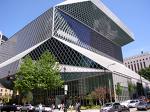 Rem Koolhaas just spoke at the National University of Singapore, he
had banked on a general audience, however he got a bunch of architects (he polled the audience at the beginning of the talk).
Rem Koolhaas just spoke at the National University of Singapore, he
had banked on a general audience, however he got a bunch of architects (he polled the audience at the beginning of the talk).
 Rem Koolhaas just spoke at the National University of Singapore, he
had banked on a general audience, however he got a bunch of architects (he polled the audience at the beginning of the talk).
Rem Koolhaas just spoke at the National University of Singapore, he
had banked on a general audience, however he got a bunch of architects (he polled the audience at the beginning of the talk).
While his talk showcased the Seattle public library and the CCTV building, he spent the bulk of it reviewing his prior work on Singapore (not sure which book, have to go read), and others such as Evil Paradises. Oddly, he segued from architecture to design of other items such as the EU barcode flag mentioned in the above wikipedia article, and consulting for Conde-Nast and Wired Magazine.
Reading between the lines, the expansion into non-architecture design seems driven by either competition ( too much in architecture ) or economic recession ( has idle design people ). I can see a probable future where we have applications that contain the technical materials science part of architecture, which leave the humans to run pure design ( imagine Google Sketchup that understands materials + finite element analysis = it won't let you build something that won't pass code or fall down ;). Plenty of people will be able to design what they want.
In the Q&A session, I asked him how architects will deal with people's increasing desire and ability to design while avoiding an ugly collage of modern buildings (one of his first slides was a not-pretty collage of modern buildings to create a skyline). He didn't get the question (or punted to a sales-oriented point), so he dwelled on the flexibility that he built into the Seattle public library.
Architects should help design regulations that let people to design what they want, the sum of those individual efforts create an emergent order which has functionality and some notion of beauty. Like Manchester, UK's unplanned nature that ends up making something distinctly relevant to the populace.
Postscript: the talk suffered from several avoidable technical failures: